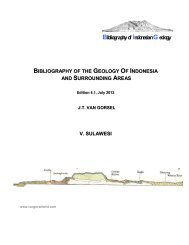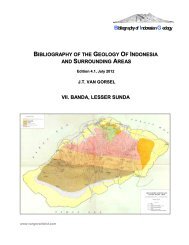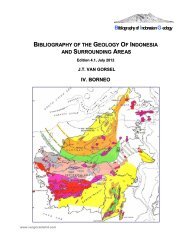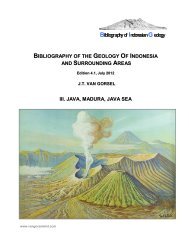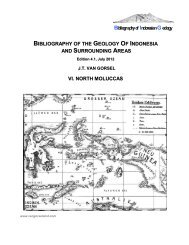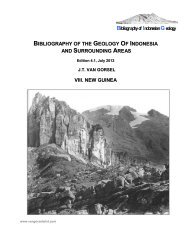Sumatra, Sunda Shelf, Natuna - Bibliography of Indonesia Geology
Sumatra, Sunda Shelf, Natuna - Bibliography of Indonesia Geology
Sumatra, Sunda Shelf, Natuna - Bibliography of Indonesia Geology
You also want an ePaper? Increase the reach of your titles
YUMPU automatically turns print PDFs into web optimized ePapers that Google loves.
Sitanggang, J.M. (1983)- The use <strong>of</strong> alkali elements as a guide to tin mineralization in some granite rocks in the<br />
island <strong>of</strong> Bangka. Proc. 12th Ann. Conv. Indon. Assoc. Geol. (IAGI), p. 163-167.<br />
Sitanggang, J.M. (1986)- Distribution <strong>of</strong> major and some trace elements <strong>of</strong> some granites from Bangka,<br />
<strong>Indonesia</strong>. In: G.H. Teh & S. Paramananthan (eds.) Proc. GEOSEA V Conf., Kuala Lumpur 1984, 2, Geol. Soc.<br />
Malaysia Bull. 20, p. 401-422.<br />
Sitha, K., L.D. Setijadji, K. Sanematsu, T. Ikuno, A. Imai, A. Dimara & K. Watanabe (2009)- REE in monzogranites<br />
in Bangka Island, <strong>Indonesia</strong>. Proc. 2nd Reg. Conf. Interdisc. Res. Natural Resources and Materials<br />
Engineering, Yogyakarta 2009, p.<br />
Slik, JW.F., S. Aiba, M. Bastian, F.Q. Brearley, C.H. Cannon, K.A.O. Eichhorng, G. Fredriksson et al. (2011)-<br />
Soils on exposed <strong>Sunda</strong> shelf shaped biogeographic patterns in the equatorial forests <strong>of</strong> Southeast Asia. Proc.<br />
Nat. Acad. Sci. USA 108, 30, p. 12343-12347.<br />
(Marked present-day biogeographic difference between W (Malay Peninsula, <strong>Sumatra</strong>) and E <strong>Sunda</strong>land<br />
(Borneo) surprising as these areas formed single landmass for long time in Pleistocene. Dry savanna corridor<br />
dispersal barrier during glacial maxima proposed to explain this, but short duration <strong>of</strong> dry savanna conditions<br />
make it an unlikely sole cause. Analysis <strong>of</strong> tree inventories suggest exposed sandy sea-bed soils acted as<br />
dispersal barrier; no confirmation <strong>of</strong> savanna corridor)<br />
Smit Sibinga, G.L. (1949)- Pleistocene eustasy and glacial chronology in Java and <strong>Sumatra</strong>. Verhand. Nederl.<br />
Geol.-Mijnbouwk. Gen., Geol. Ser. 15, p. 1-31.<br />
Soeria-Atmadja, R., D. Darda & D. Hasanuddin (1986)- Some aspects <strong>of</strong> southern granitoid complex and tin<br />
mineralization in the northern part <strong>of</strong> Bangka, <strong>Indonesia</strong>. In: G.H. Teh & S. Paramananthan (eds.) Proc.<br />
GEOSEA V Conf., Kuala Lumpur 1984, 1, Geol. Soc. Malaysia Bull. 19, p. 349-367.<br />
(Petrographic details <strong>of</strong> S-type granitoids <strong>of</strong> Bangka. Tin mineralization mostly along WNW, NNE and N-S<br />
directions, seem related to Late Triassic deformation)<br />
Stattegger, K., W. Kuhnt, H.K. Wong, C. Buhring, C. Haft, T. Hanebuth et al. (1997)- Sequence stratigraphy,<br />
Late Pleistocene- Holocene sea level fluctuations and high resolution record <strong>of</strong> the Post-Pleistocene<br />
transgression on the <strong>Sunda</strong> <strong>Shelf</strong>. Cruise Report Sonne 115, <strong>Sunda</strong>flut, Univ. Kiel, Geol.-Pal. Institut, Reports<br />
86, 211p.<br />
Steinke, S., T.J.J. Hanebuth, C. Vogt & K. Stattegger (2008)- Sea level induced variations in clay mineral<br />
composition in the southwestern South China Sea over the past 17,000 yr. Marine Geol. 250, p. 199-210.<br />
(Variations in clay mineral composition <strong>of</strong> <strong>Sunda</strong> <strong>Shelf</strong> margin and slope cores over past 17,000 yrs. Deglacial<br />
sea level rise principal factor driving changes. Late Glacial high kaolinite reflect higher contribution <strong>of</strong> clays<br />
from soils formed on exposed <strong>Sunda</strong> <strong>Shelf</strong>. After coastline retreated close to present-day position in mid-<br />
Holocene stronger influence <strong>of</strong> illite-rich sources (e.g. Borneo))<br />
Steinke, S., M. Kienast & T. Hanebuth (2003)- On the significance <strong>of</strong> sea-level variations and shelf paleomorphology<br />
in governing sedimentation in the southern South China Sea during the last deglaciation. Marine<br />
Geol. 201, p. 179-206.<br />
(Quaternary deglacial sedimentation on outer <strong>Sunda</strong> <strong>Shelf</strong>, shelf margin and slope controlled by shelf paleophysiography<br />
and changes in sea level and sediment supply. Five sites along transect across outer shelf and<br />
continental slope document four intervals <strong>of</strong> significant depositional changes in last 20 000 years: drowning <strong>of</strong><br />
lower course <strong>of</strong> North <strong>Sunda</strong> (Molengraaff) River (16.5-14.5 ka), rapid rise in sea level with flooding <strong>of</strong> middle<br />
part <strong>of</strong> paleo-valley at 14.5-14 ka and flooding <strong>of</strong> surrounding plains <strong>of</strong> river valley (14-8.5 ka). Coastline<br />
reached modern position between ca. 8.5- 6 ka)<br />
Strimple, H.L. & T.E. Yancey (1976)- Moscovicrinus preserved in magnetite from Selumar, Belitung Island,<br />
<strong>Indonesia</strong>. J. Paleontology 50, 6 p. 1195-1202.<br />
<strong>Bibliography</strong> <strong>of</strong> <strong>Indonesia</strong> <strong>Geology</strong> v. 4.1 137 www.vangorselslist.com July 2012



